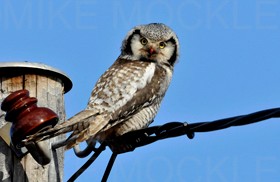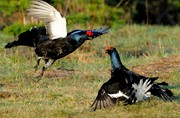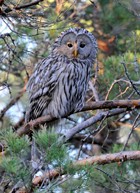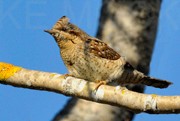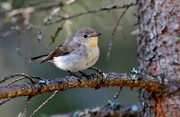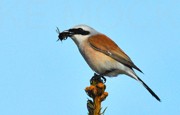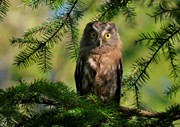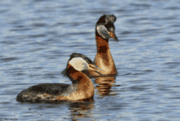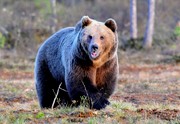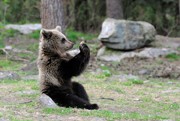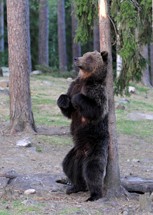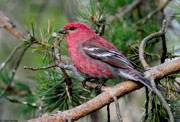Mike Mockler Arctic Finland & Norway |
Mike has visited Finland around twenty times and considers it one of his favourite European countries. On this trip, as usual, the main focus was on the northern half of the country, including the Arctic Circle. In addition, there were four days in the far north-east of Norway. On this trip, instead of a group, Mike was accompanied by his wife, Pat, so there was less emphasis on the photographic side of things. Even so, Mike still managed to obtain images of a variety of species, including two or three he had never photographed before. For the first leg of the tour, Mike and Pat were based in Oulu and, with the help of Jari Peltomaki, many excellent species were seen including Tengmalm’s Owl, Pygmy Owl, Short-eared Owl, White-tailed Eagle, Marsh Harrier, Goshawk, Honey Buzzard, Common Crane, Black Woodpecker, Three-toed Woodpecker, Ruff, Hazel Grouse, and Common Rosefinch. The main highlight was a Black Grouse lek where around 24 males postured, displayed and battled right in front of the small hides where Mike and Pat sat in the early hours of the morning. In addition, Mike was delighted to be able to photograph Ural Owl, Red-breasted Flycatcher, Ortolan Bunting, Wryneck and Red-backed Shrike. Mike and Pat then drove to the Russian border where four nights were spent in bear-watching hides in two different locations. Although Mike had used such hides many times before, this was Pat’s first experience of watching European Brown Bears, though in Canada she had previously seen Grizzlies, which are essentially the same species. Photographers are taken to the hide at 4pm and collected at 7am the following morning. Four consecutive days of this regime can play havoc with one’s body-clock, especially as there are almost 24 hours of daylight! One of these locations had a reputation for occasional visits from European Wolves, which was the main reason Mike had booked there. He was rewarded on the second night when a female Wolf spent 15 or 20 minutes in front of the hide, albeit at some distance. Mike was excited by his first sighting of European Wolf but, sadly, the Wolf’s visit came at the darkest time of the night, frustrating from a photographic point of view. At this latitude, although it is light for most of the night, it is too dark for successful photography during two or three hours around midnight. Even so, it was wonderful to watch the Wolf interacting with the Bears. Surprisingly, although it was alone, the Wolf was totally dominant and twice caused fully-grown Bears to run away in panic. It really was amusing to watch the Bears running at full speed with the Wolf in hot pursuit! For the next sector Mike and Pat drove further north, close to the Arctic Circle. One great delight was watching five male Capercaillies lekking on the first morning. Other sightings here included such elusive and highly-prized species as Red-flanked Bluetail, Hazel Grouse, Little Bunting, Siberian Tit and Siberian Jay. Photographic opportunities were limited but Mike was pleased to get shots of the splendid Red-necked Grebe, a species he had never previously managed to photograph, as well as Willow Grouse, Sedge Warbler and Wood Sandpiper. Finally, the journey continued to the far north, deep inside the Arctic Circle. Here Pine Grosbeaks were among the most prized sightings and photographic subjects. Another highlight was a Great Grey Owl spotted by Pat from the car. In most years, this wonderful owl is quite common in Finland but 2012 was a disastrous year for most owl species, including Great Grey Owl. Following a major crash in the vole population, many species of owl disappeared. Most of them probably moved to areas where they could find food but, sadly, it is likely that many died. Inland, high on the tundra, there was still considerable snow-cover and many lakes were completely frozen. The scenery was as breathtaking as ever but most of the tracks that Mike had driven in previous years to find the more elusive species were impassable under deep snow. Furthermore, some species had still not arrived on their nesting grounds. Nevertheless, with patience and perseverance, Mike managed to track down all the desired “high tariff” species. These included Gyrfalcon, Rough-legged Buzzard, Red-necked Phalarope, Dotterel, Temminck’s Stint, Ptarmigan, Long-tailed Duck, Long-tailed Skua, Bluethroat, Red-throated Pipit, Shorelark and Lapland Bunting. On the final leg of the tour, Hawk Owls provided great entertainment and excellent photo opportunities. One was seen on three occasions hunting close to the road, perching on telephone wires and even rooftop TV aeriels. At one point, as it hunted small birds beside the road, it seemed as if it was about to fly into the open car window! Not far away, a pair of Hawk Owls had nested close to the road and now had their recently-fledged small chicks on the ground in the roadside vegetation. The smallest chick was at serious risk from passing cars so Mike moved it to safety. Hawk Owls are known to attack humans in defence of their young so Mike had to be very careful while handling the chick with the parents watching. As it turned out, the two adults were incredibly relaxed. In fact, the mother fell asleep! It was one of the most memorable experiences of a memorable trip. More images from this trip can be found in the Europe / Finland section of the Photographic Gallery.
|
|
